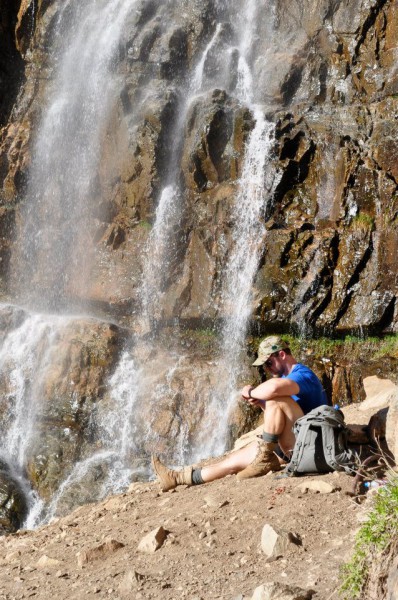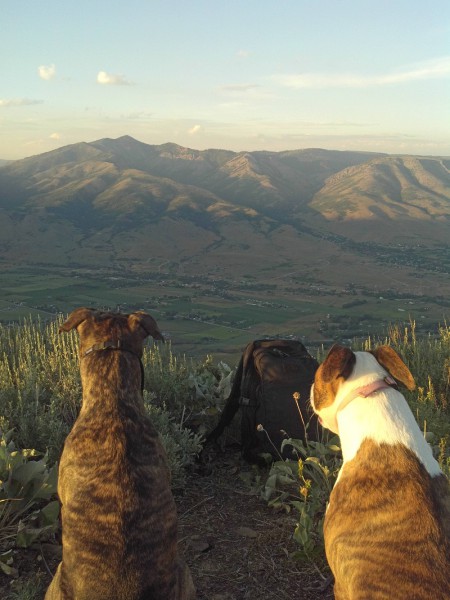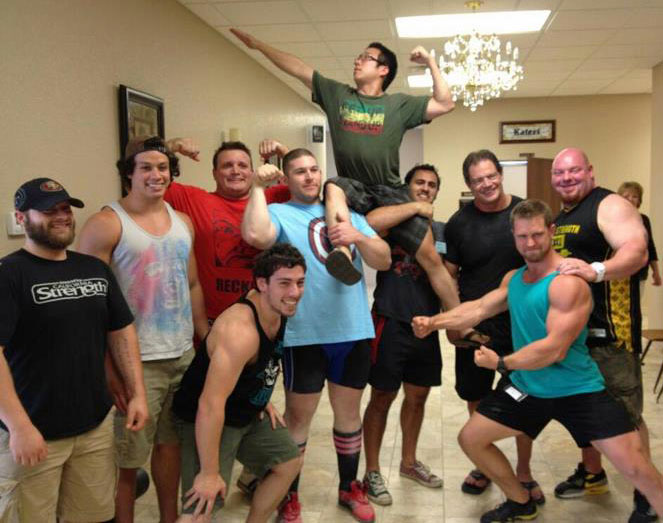GoRuck is growing. What started as a small company making high quality packs quickly turned into a challenging adventure type event that is set apart from the en vogue “adventure races”. Again, I don’t know what en vogue means, but I think you can take penicillin for it.
I originally wrote “Challenge Yourself — GoRuck” to provide another avenue of competition, introspection, and to introduce what GoRuck is. I then attended their challenge in Washington D.C. and wrote “GoRuck Challenge Review“. I think the challenge itself is a valuable learning experience relative to the individual. In retrospect, I re-learned that part of leadership is getting people to do things that they don’t want to do when they don’t think they can do it. I also learned how hard my body can be pushed on limited resources before complications arise. In my case, I didn’t get enough water (I let others refill their water systems during the short breaks), but it took eight hours of grueling activity before the cramps started. “Grueling” includes over an hour of smoking PT, carrying a 1,200 pound log with the class for a couple of hours, carrying various people for several hours, running a 5k, and more all while carrying a 40 pound pack and often carrying other objects (team weights like a full jerry can or fire hose). I’ve since completed round trip mountain summits of 16 miles and over 8,000 feet of elevation change with no qualms about my ability to complete it. I had the confidence to know that it would take a lot more physical exertion before bad things happened.
The GoRuck Challenge is worth it. It will obviously be hard — for some people it’ll be the hardest thing they’ve ever done and an epiphany in their lives. At the very least it’ll give you an appreciation for what the military and SOF community goes through in their selection, every day jobs, and deployment.
As a side note, the GoRuck gear is of the highest quality I’ve ever seen. Critics often balk at the price, but I’ve compared my GR2 (the largest pack) with 511 gear, and there is honestly no comparison. I’ll do a review on my pack on my personal log since it leaves the scope of 70sBig.com, so look out for that if you’re interested.
A lifter’s approach for training for a GoRuck will be unique. I pointed out some basic points about preparing for an event in the GoRuch challenge review post (under the spoiler below). These general recommendations apply to anyone, yet they didn’t dive into specific programming.
[spoiler]
– Program the S&C portion around the rucking; it can and will jack up the structures for efficient strength/conditioning training
– Commit to daily mobility work; rucking bashes the shoulders, neck, thoracic and lumbar spine, hips, knees, and feet. Learn your problem areas and keep them up to speed; if you slack, they will fail.
– Progress rucking slowly; your body is not ready for 50+ pound rucks for several hours. Start light and short, and linearly progress it slowly.
– Cap the weight at 50 pounds and don’t run; there’s no need to run in training because it puts too much stress on the body. Just trust me. Some infantry guys may need to run a LITTLE bit in training to prepare for a 12 mile road march, but it can fuck things up.
– Progress the overall program slowly; the body won’t be hitting everything full speed with the addition of rucking. Don’t try and squat close to your repetition PR; allow your structures and system to adapt to the new straining stress.
– Aim to toughen the feet. I wore issue desert boots until recently for the sole purpose of toughening my feet. I had a blister in March 2011 on my first ever ruck (a friend was, uh, breaking me in), and the second time I had a blister was a month or so ago when I did 8 miles in 2 hours (some of it on sand). The boots are shitty with no custom work to make them more comfortable (blister was on the back of the heel). I recently got a pair of Rocky C4 deserts and wore them during the challenge (they are similar to Nike Free deserts, but the Nikes rubbed on my pinky toes too much for my liking). I did not have any blisters, and the 12 hours of the GRC was four times as long as I’ve ever gone with a ruck on. Also, my feet were constantly wet (streams, water fountains, rivers, etc.), which is the worst thing for blister development, but I didn’t have any problems.
– Learn about blisters and how to prevent them. This book is the best available if you’re a noob. It would be relevant if you’re into hiking or mountain climbing (I am). Learn how shoes and socks should fit. I wore dress socks under moisture-wicking socks to reduce friction on my feet; it was the first time I did it, and I had zero problems (other than really pruny feet from being wet for 12 hours).
– Learn proper hydration and electrolyte consumption. My longest ruck or hike has been three hours. When the sun started coming up, I started to have some small cramps in my quad (we had to do walking lunges). I was soon the TL, and my various parts of my legs from the hip down tried to seize on me during our movement (have you ever had your adductor muscles cramp?). I later had a full-blown calf cramp in the swamp. This all could have been prevented with better hydration; by the time I needed the water, it was too late. I had a water bladder, but I emptied it several times and couldn’t keep enough water in me. I opted several times during my TL stint to give my water to other people so that we could make time. The problem is that I have a lot of muscle mass, and it burns through water like an engine does gasoline. In the future I would have two bladders and drink on them constantly. My last several hours would have been much easier had I done so (I was pretty hobbled).
[/spoiler]
I’ve rucked or hiked at least once a week almost every week for over a year now. Behind the scenes I work with various military and SOF personnel and rucking gives me perspective on their demands. Recently, I’ve done a lot more adventuring to include more longer, lighter efforts. My week may vary between a 60+ pound hour walk with the dogs in hilly terrain or an 8 hour, 16 mile affair with over 8,000 ft of total elevation change with about 30 pounds. Throughout all of this time, I’ve maintained or improved my strength, lean body mass, and body composition. I’ve hit PRs or almost PRs in the Olympic lifts several days after 15+ mile hikes. I’ve also bounced ideas off of various infantry and SOF personnel around the world; they are the guys that have the most experience with it. I’m giving you my perspective to validate the ideas presented below.
Most of all, this means I’ve learned what not to do. I’ve trained after brutal hikes and at best had poor training sessions and at worst tweaked something. It’s given me insight on preparing guys for combat, but it’s given me insight on how to arrange training in order to be an adventurer. Can you complete a GoRuck with little training? Of course; there’s not much you can do to prepare for a kick in the balls. However, the experience doesn’t have to be injurious. But it all starts with the basics.
A Good Foundation Helps
This should be obvious, but having a basic capacity will facilitate quality ruck training. Guys in the military are often exposed to PT in basic training before loaded with a ruck. The exposure increases until they are finally doing a 12 mile road march, or other service equivalent, in a combat arms job. So it should be for you. If you have existing injuries in the ankles, knees, hip, or back, then work to eradicate or improve these issues prior to loading your body.
You’ll perform better and your body will hold up better when it’s strong. If you’re reading this site, then you won’t be entirely weak, so the real issue is getting you ready to handle rucking stresses. This stuff should be progressed in a respectful manner. I know 30 pound doesn’t seem like much, but put it on your back and walk for 45 minutes. Every non-military guy I know who has tried it was humbled.
I think that some basic pre-rucking qualifications for a non-conditioned lifter will be to run a mile or jump rope for five minutes without complication. Both are simple tasks that every human should be capable of. If either causes significant soreness (mostly in joints), then it would behoove the trainee to adapt to these activities. After all, the GoRuck will have some running, especially in a fatigued state.
Tough feet are important to prevent blisters. As part of the foundation, start going outside with your shoes off. Walk your dogs without shoes and spend as much time as you can outside. This will help harden the feet which only augments them when they are in a boot. If walking on concrete is painful, then toughening the feet is a useful and necessary human skill. You’ll be amazed at how sheltered people’s feet are.
Get Time Under The Ruck
The next important point is that you’ll need to get time under a ruck. Is it possible to do the event with zero rucking preparation? Yes. But if you read the challenge review, a kid named Ray didn’t have any preparation and he was hurting. Ray contemplated quitting a lot, but to his credit he finished. Yet he was literally hobbling to the finish because his feet and ankles were so badly beat up. While CrossFit can prepare folks for elongated activity, specificity is necessary because there’s no substitute for accumulating time with weight on your back.

Waterfall Canyon near Ogden, UT prior to the GoRuck Challenge. I carried about 20kg of rocks up this short trail wearing short shorts.
Start out light and short; 25 pounds for half an hour will do it. If you get done and think, “No sweat! That was easy!” Good. We don’t want to induce harm. Ruck at least once a week and at most three times a week with at least one day of rest in between sessions. If you’re going to train on the same day, then ruck after lifting. After any rucking session, if it spanks you, then repeat the weight and duration again before advancing either. Progressing the load or duration too quickly can inhibit your lifting and even result in an injury. Even minor tweaks from rucking can prevent squatting for a month.
I suggest only doing one or two ruck sessions a week. Feel free to do them on the road, but I prefer trails. You won’t necessarily need to worry about speed; the GoRuck is a team event instead of an individual speed event for time like the Army’s 12 mile road march.
If 25 pound for half an hour was fine, then increase the duration by 15 minutes. Increase duration before increasing load. Work towards an hour with 25 pounds, complete it a couple of times, and then increase the weight to 30 to 35 pounds. If the 25 pounds for an hour was hard, reduce the time to 45 minutes when increasing the weight, otherwise repeat 60 minutes. Your goal is to increase the amount you can carry for one hour. It’s not necessary to exceed 50 pounds — your six bricks plus water/food will weigh about 35 pounds during the challenge, and then submerging your packs in water will add another 5 pounds or so. The weight will range between 35 and 45 pounds for a male, so working with anything over 50 pounds isn’t necessary and can be injurious.
Once you have moved your hour-long ruck over 35 pounds, and you have the time and the gumption, you can start pushing into longer movements. Cap the overall duration at 3 hours, but it isn’t necessary to go above 2 hours, especially since you need to lift during the week. I didn’t do anything over 2 hours before the challenge (I did one movement that went 8 miles in 2 hours on flat terrain with the dogs, who slowed me down to take dumps). Whenever you increase the duration, stick with 35 pounds. For the sake of a GoRuck Challenge, you won’t need to do 2 hours with 50 pounds, so just progressively add 15 minute intervals with 35 pounds. If your body feels banged up, just repeat that same session again before progressing.
At most, you’ll handle 50 pounds. At longest, you’ll go 2 to 3 hours. Stick to around 35 pounds for the longer movements. If you are going to ruck twice a week, then do one short, and one longer. You’ll want more rest after a longer movement, so do it on a Friday or Saturday and rest throughout the rest of the weekend.
While Rucking
Aim to move out with purposeful strides. Meandering like a tourist will be better than nothing, but during the GoRuck your speed can be very slow (when carrying things) or a decently paced run. It’s better to be accustomed to a mall walk. I’ve heard of people getting sore calves from rucking or hiking; don’t aim to “toe off” of the ground, aim to drive your heel back. You want the larger posterior chain muscles to be your motor instead of the smaller calf muscles.
Always bring water. I usually didn’t use it on the hour long movements, but it’s better to have it and not need it than to need it and not have it. Some people have the idea that they will train to plan for lack of water and food, but this is a bad and stupid idea. Don’t put yourself in harm; there’s not really anyway you can prepare for the mental aspect of a GoRuck.
If you’re going for longer movements in the wilderness, then plan accordingly. Snacks, water, flashlight, fire starting capabilities, knife, and gun if you have it. Turn your phone on sleep if so you have battery if necessary and put it in a ziploc bag if rain is on the forecast. Bring a whistle so you can make a bunch of noise if you break a bone and can’t move. When you don’t respect nature, that’s when it’ll bite you in the ass. The same goes for asshole people who may try to take advantage of you or harm you; it’s up to you to protect yourself.
Keep an eye on your feet; they are the most important aspect of rucking. If the feet are blistered, it’ll hinder everything you do. Properly fitted and broken in foot wear is vital. I like to wear boots and have used GI desert boots an infantry friend gave me. They used to chew my feet up decently, but now, without any custom work done on them, they are my most comfortable boot. I have confidence that I can move up to 20 miles without blisters. Note that I purposely wore them in the beginning to toughen my feet. I bought a pair of boots that are similar to the Nike Free boots to use for the GoRuck. They worked splendidly despite my feet being completely wet the entire challenge; I didn’t have any blisters. However, they gave me heel blisters in the first 45 minutes of climbing Ben Lomond, a mountain in the Wasatch Range in northern Utah. I ended up dealing with the blisters for the next 7 hours. Test your foot wear in climbing up hill, going down hill, and on flat terrain. You don’t want your heel to rub on the way up or your toes to smash the toe box on the way down. Most people wore trail running shoes at the challenge and seemed to not have any foot issues.
Lifting Around the Rucking
How to structure the weekly template is most relevant to a trainee. Never train the day after a GoRuck. At best general fatigue will limit the session and at worst you may have lingering joint soreness that is tweaked during the lifting. Always have at least one day of rest after a ruck. For longer movements, take two days of rest. I’ve taken as many as three or four days of rest after long hikes (specifically before an Olympic lifting session).
If you train Monday, Wednesday, and Friday, then you can ruck on Saturday. You could also ruck on Wednesday after training. If you rucked on Tuesday or Thursday, then the subsequent training day would need to be modified to be less stressful. There was a point where I did a short/heavy ruck on Thursday, a light lifting session on Friday (barbell rows, weighted pull-ups, and farmer’s walks), followed by a long/light ruck on Saturday. I still lifted on Friday, but I removed any movements that would have been affected by the Thursday rucking. The MWF had a “heavy-medium-light” approach.
If you train Monday, Tuesday, Thursday, and Friday, then the best days to ruck would be Tuesday and Saturday. Tuesday’s ruck would be followed by a complete day of rest, and the Saturday morning session will allow the rest of the weekend for rest.
If you only aim to ruck once a week, then Saturday is probably the best option to avoid interfering with your lifting schedule. If you progress it well, as indicated above, then you shouldn’t have any joint or muscular issues. The most likely interference will have to do with limited mobility. Walking with 40 pounds for an hour and then trying to hit a seamless snatch a couple of days later are dichotomous methods of training. Prepare to work on your ankles, calves, knees, hips, and shoulders in preparation of avoiding problems from rucking (future posts will include mobility solutions).
In addition to lifting and rucking, add some calisthenics once or twice a week. If you’re limited on time, just use pull-ups, push-ups, and squats. It’s easy to do a quick “5 rounds of Cindy” after a training session. “Cindy” is a CrossFit workout of doing as many rounds in 20 minutes of 5 pull-ups, 10 push-ups, and 15 squats. Don’t worry about 20 minutes, just work on doing timed sessions of 5 to 10 rounds. Add up your total number of reps for a given exercise and make sure this total progresses appropriately. If you up and do 100 pull-ups in a day (dead hang, of course), then you’ll probably have lingering soreness that interferes with pressing, benching, or deadlifting (fatigued shoulder extensors would not help keep the bar against the legs). You’ll end up doing sit-ups and flutter kicks at the challenge, but you’re going to do so many calisthenics beyond fatigue it doesn’t really matter. As long as you have a decent strength, mobility, and endurance (i.e. fitness), you’ll be fine.
The GoRuck Challenge is supposed to be hard, especially for a goober civilian who has never walked over ten miles with a load. By adding correctly programmed rucks into the training, you can adequately prepare for the challenge while still maintaining your normal lifting schedule. Getting time under a ruck will make the experience less agonizing and let you be a relevant member of the team instead of shutting down and ignoring the world. The challenge is designed to get harder through the night. By preparing for the event intelligently, you’ll be able to more effectively make a contribution to the team. Especially when the going gets tough. And the cadre will make it GoRuck Tough.







